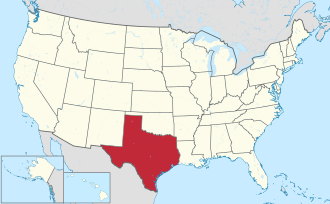County established and growth
In 1825, empresario Green DeWitt [10] received a grant from the Coahuila y Tejas legislature to settle 400 families. [11] [12] Between 1826 and 1831 [13] settlers arrived from Tennessee, Kentucky, Missouri, and other Southern states.
A temporary county government was set up in 1846, with the county seat being Daniel Boone Friar's store at the junction of the La Bahía Road and the Gonzales-Victoria road. [14] On November 28, 1850, Clinton became the county seat until Cuero became county seat in 1876.
Dewitt County voted in favor of secession from the Union, and sent several military units [15] to serve. During Reconstruction, the county was occupied by the Fourth Corps, based at Victoria.
From April 1866 until December 1868, a sub-assistant commissioner of the Freedmen's Bureau [16] [17] served at Clinton. The community of Hopkinsville was established in 1872 by Henry Hopkins, freedman former slave of Judge Henry Clay Pleasants, [19] the judge credited for ending the Sutton-Taylor Feud. Residents began a school that was active until 1956, and established the Antioch Baptist Church.
The notorious Sutton–Taylor feud [20] [21] began as a Reconstruction-era county law enforcement issue between the Taylor family and lawman William E. Sutton. It eventually involved both the Taylor and Sutton families, the Texas State Police, the Texas Rangers, and John Wesley Hardin. The feud, which lasted a decade and cost 35 lives, has been called the longest and bloodiest in Texas history.
April 1, 1866, marked the first cattle drive on the Chisholm Trail, [22] which originated at Cardwell's Flat, near the present Cuero. The coming of the railroads eliminated the need for the Chisholm Trail. Dewitt's first rail line, the Gulf, Western Texas and Pacific, [23] extended to San Antonio. The San Antonio and Aransas Pass Railway, [24] was the second line in the county. In 1907 the Galveston, Harrisburg and San Antonio Railway [25] came through Dewitt. In 1925, the three lines came under the control of the Southern Pacific lines and operated as the Texas and New Orleans Railroad. [26] Passenger service continued until November 1950.
The United States Army Air Corps opened Cuero Field, [27] serving 290 cadets, at Cuero Municipal Airport as a pilot flight school in 1941. The school was deactivated in 1944.
Cuero and its large turkey-growing industry bills itself as the "Turkey Capital of the World". The turkey industry in Cuero began large-scale operations in 1908. Much like ranchers had cattle drives, Cuero poultry growers drove their turkeys down Main Street to the local packing plant. [28] Each year, the crowds grew to watch the sight and sound of upwards of 20,000 turkeys going through town. [29] The first annual Cuero Turkey Trot [30] celebration began in 1912, complete with the "Turkey Trot" dance music of the era. By the 1970s, [31] the event had become a 3-day typical Texas celebration with parades, live entertainment, food booths, and street dances.



